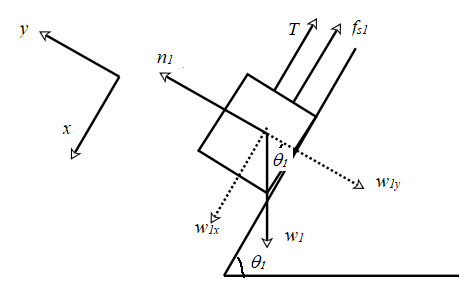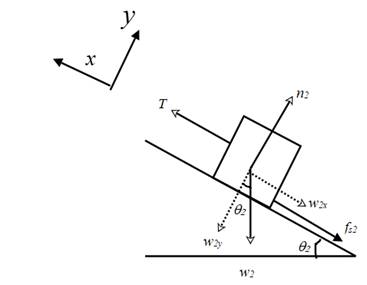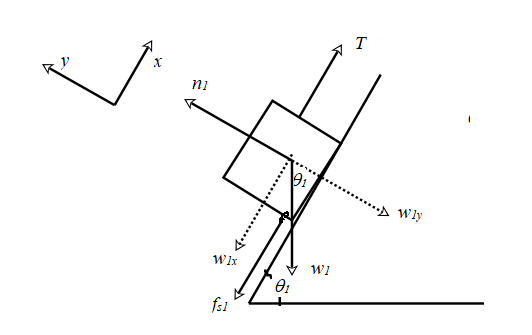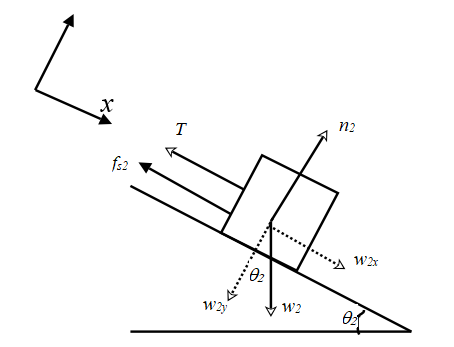
Concept explainers
The range of the values of the mass m2 so that the two connected blocks resting on two inclined planes are in equilibrium.
Answer to Problem 83QAP
The mass m2 can have values between 3.51 kg and 52.64 kg for the system of masses to be in equilibrium.
Explanation of Solution
Given info:
Formula used:
From the diagram given, if the value of m2 falls below a certain value, it would slide up the plane and the block of mass m1 would slide down. This gives the value of the minimum mass of m2.
If the value of m2 increases beyond a certain value, the block would slide down the plane and the block of mass m1 would slide up.
By drawing the free body diagrams for each case, and applying the force equations for each case, the range of the values of m2 can be determined.
Explanation and Calculation:
Case 1:
Consider the case when the block 1slides down the plane and the block 2 slides up the plane.
The free body diagram for m1 is shown below:
The block rests on an incline which makes an angle

The weight
Resolve the weight w1 into components along the +x and −y directions as shown. The magnitudes of the components are given by,
Write the force equation along the +y direction.
Since the block is in equilibrium,
Therefore,
The force of friction is given by,
The system is in equilibrium along the x direction too. Therefore,
Using equations (1) and (2), in the above equation,
In a similar manner, construct a free body diagram for the block 2.
The block rests on an incline which makes an angle

The weight
Resolve the weight w2 into components along the −x and −y directions as shown. The magnitudes of the components are given by,
Write the force equation along the +y direction and apply the condition for equilibrium.
Therefore,
The force of friction is given by,
The system is in equilibrium along the x direction too. Therefore,
Using equations (4) and (6), in the above equation,
Add equations (3) and (7) and write an expression for m2.
Substitute the known values of the variables in the expression and calculate the value of m2.
The minimum value of m2 for which the system is in equilibrium is 3.51 kg.
Case 2:
Consider the case when the block 1slides up the plane and the block 2 slides down the plane.
The free body diagram for m1 is shown below:
Assume the +x direction up the incline and the +y direction perpendicular to the plane. The weight

The equations (1) and (2) are applied to this free body diagram too.
Write the condition for equilibrium along the x direction.
Use equations (1) and (2) in the expression.
In a similar manner, construct a free body diagram for the block 2.
. Assume a coordinate system which has the +x direction pointing down the plane and the +y direction perpendicular to the plane away from it. The weight

The equations (4), (5) and (6) are valid for this case too.
Write the equation for equilibrium along the x direction.
Using equations (4) and (6) in the expression,
Add equations (8) and (9) and write an expression for m2.
Substitute the known values of the variables in the expression.
The maximum value of m2 for the system to be in equilibrium is 52.64 kg.
Conclusion:
Thus, the mass m2 can have values between 3.51 kg and 52.64 kg for the system of masses to be in equilibrium.
Want to see more full solutions like this?
Chapter 5 Solutions
COLLEGE PHYSICS
- Rod AB is fixed to a smooth collar D, which slides freely along the vertical guide shown in (Figure 1). Point C is located just to the left of the concentrated load P = 70 lb. Suppose that w= 17 lb/ft. Follow the sign convention. Part A Figure 3 ft -1.5 ft √30° 1 of 1 Determine the normal force at point C. Express your answer in pounds to three significant figures. ΜΕ ΑΣΦ Η vec Nc= Submit Request Answer Part B Determine the shear force at point C. Express your answer in pounds to three significant figures. VC= ΜΕ ΑΣΦΗ vec Submit Request Answer Part C Determine the moment at point C. Express your answer in pound-feet to three significant figures. Mc= Ο ΑΣΦ Η vec Submit Request Answer Provide Feedback ? ? lb lb ? lb-ftarrow_forwardConsider a uniformly charged ring of radius R with total charge Q, centered at the origin inthe xy-plane. Find the electric field (as a vector) at a point on the z-axis at a distance z above thecenter of the ring. Assume the charge density is constant along the ring.arrow_forward3) If the slider block C is moving at 3m/s, determine the angular velocity of BC and the crank AB at the instant shown. (Use equation Vs Vc wx fuc, then use equation Vs VA + Ve/athen write it in terms of w and the appropriate r equate the two and solve) 0.5 m B 1 m 60° A 45° vc = 3 m/sarrow_forward
- 3) If the slider block C is moving at 3m/s, determine the angular velocity of BC and the crank AB at the instant shown. (Use equation Vs Vc wxf, then use equation V, VA + Va/Athen write it in terms of w and the appropriate r equate the two and solve) f-3marrow_forwardPls help ASAParrow_forwardPls help ASAParrow_forward
- 14. A boy is out walking his dog. From his house, he walks 30 m North, then 23 m East, then 120 cm South, then 95 m West, and finally 10 m East. Draw a diagram showing the path that the boy walked, his total displacement, and then determine the magnitude and direction of his total displacement.arrow_forwardPls help ASAParrow_forwardPls help ASAParrow_forward
- Pls help ASAParrow_forwardPls help ASAParrow_forward12. A motorboat traveling 6 m/s, West encounters a water current travelling 3.5 m/s, South. a) Draw a vector diagram showing the resultant velocity, then determine the resultant velocity of the motorboat. b) If the width of the river is 112 m wide, then how much time does it take for the boat to travel shore to shore? c) What distance downstream does the boat reach the opposite shore?arrow_forward
 Classical Dynamics of Particles and SystemsPhysicsISBN:9780534408961Author:Stephen T. Thornton, Jerry B. MarionPublisher:Cengage Learning
Classical Dynamics of Particles and SystemsPhysicsISBN:9780534408961Author:Stephen T. Thornton, Jerry B. MarionPublisher:Cengage Learning Principles of Physics: A Calculus-Based TextPhysicsISBN:9781133104261Author:Raymond A. Serway, John W. JewettPublisher:Cengage Learning
Principles of Physics: A Calculus-Based TextPhysicsISBN:9781133104261Author:Raymond A. Serway, John W. JewettPublisher:Cengage Learning Physics for Scientists and Engineers, Technology ...PhysicsISBN:9781305116399Author:Raymond A. Serway, John W. JewettPublisher:Cengage Learning
Physics for Scientists and Engineers, Technology ...PhysicsISBN:9781305116399Author:Raymond A. Serway, John W. JewettPublisher:Cengage Learning Physics for Scientists and Engineers: Foundations...PhysicsISBN:9781133939146Author:Katz, Debora M.Publisher:Cengage Learning
Physics for Scientists and Engineers: Foundations...PhysicsISBN:9781133939146Author:Katz, Debora M.Publisher:Cengage Learning College PhysicsPhysicsISBN:9781305952300Author:Raymond A. Serway, Chris VuillePublisher:Cengage Learning
College PhysicsPhysicsISBN:9781305952300Author:Raymond A. Serway, Chris VuillePublisher:Cengage Learning Glencoe Physics: Principles and Problems, Student...PhysicsISBN:9780078807213Author:Paul W. ZitzewitzPublisher:Glencoe/McGraw-Hill
Glencoe Physics: Principles and Problems, Student...PhysicsISBN:9780078807213Author:Paul W. ZitzewitzPublisher:Glencoe/McGraw-Hill





